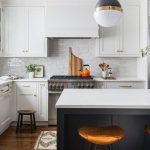10 Timeless Kitchen Trends That Will Never Go Out Of Style
By Jennifer Geddes
So if you want a kitchen you’ll love for years to come (or maybe even sell sometime in the future), it’s smart to stick with what’s tried and true. To help in this endeavor, our “Timeless Home Design Trends” series tackles your design conundrums room by room. Here are the top 10 kitchen trends where you can’t go wrong.
1. White cabinets
Whether you choose glossy acrylic or matte, white cabinets always looks clean and fresh, points out Ana Cummings of the eponymous design firm. And frankly, how many dark or black kitchens have you ever seen?
Lean hard on white if you’re redoing your cook space because the shade helps to reflect light, making your room look larger. And a white kitchen goes with every other color or texture you’d like to bring in, making this spot an easy one to design.
2. Marble counters
Marble is the Energizer Bunny of the kitchen world—it just keeps going and going and going.
“It’s really impressive to see centuries-old buildings in Europe made from marble, so you know this material is going to last in your kitchen just fine,” says Cummings.
Many homeowners prefer this counter material, even though it’s porous and maintenance can be a headache.
If you’re looking for an alternative, try white quartzite.
“It looks like marble, but it’s more durable—or consider engineered quartz like Caesarstone, which is amenable to mitering,” says Debra Kling, a home interior pro and color consultant.
3. Stainless-steel appliances
This material is a classic in part because it goes with many modern, streamlined styles as well as more ornate kitchens too, notes Amy Bly of Great Impressions Home Staging and Interiors.
“This [type of] appliance also reads cool and clean, so it’s a solid choice for an upgraded look,” adds Cummings.
And fortunately for tidy homeowners, some stainless steel requires less maintenance as technology has improved, and even stainless-steel appliances that are fingerprint-free are available. This beauty ($3,399, Home Depot) promises to keep your produce extra fresh, will accommodate large platters, and features an interior water dispenser so as not to mar the smooth exterior design.
4. Shaker-style cabinets
Keep it simple, people, and stick with flat-front Shaker designs (like this one from Lowe’s) when considering cabinet styles in the kitchen.
“This look is ubiquitous and feels safest for most homeowners—and while Shaker cabinets feel somewhat modern, they also combine well with rustic elements like open shelves,” notes Kling.
5. Subway tile
Subway tile has it all: It’s easy to install, it’s relatively inexpensive, and it has a pleasant pattern that doesn’t compete for visual attention, says Cummings.
Not sure you love these rectangles? Try the 4-by-4-inch white squares or hexagon versions, suggests Kling.
6. Open shelving
Despite the cons that crop up when people think about open shelving (dust collects, items need frequent straightening), open shelves are here to stay. And installing them breaks up the monotony of a long row of upper cabinets, allowing you a spot for interesting, thoughtful displays, says Cummings.
7. Kitchen islands
Whether your island is a free-standing table or a built-in behemoth, few homeowners are willing to cast this expansive workspace and storage space aside. Choose from natural wood, painted finishes, or brightly colored lacquers.
8. Hardwood floors
Real wood is beautiful thanks to the various shades, visual texture, and natural grains. And home buyers tend to favor real wood, so installing them can increase your home’s value. Hardwood floors are also softer underfoot than stone or tile, saving wear and tear on your back and knees.
9. Oversize sinks
“Why, I’d love a tiny sink where I can wash a bulky lasagna pan and a big pile of spinach,” said no one, ever.
A large, deep sink is just plain practical, so go for the biggest, nicest one you can afford—and you won’t be sorry. An apron-front or farmhouse-style sink will go the distance, especially this single-bowl stunner made from fireclay ($1,029.99, Wayfair).
10. Integrated appliances
A wall of built-in, coordinating cabinet fronts that hide your dishwasher and fridge may seem dull and matchy-matchy, but this streamlined, seamless look is definitely timeless.
Integrated appliances are less bulky than, say, a fridge that stands alone, and they save space (a cabinet can become a freezer). And syncing cabinets with appliance fronts adds more warmth than a bunch of metal can.



